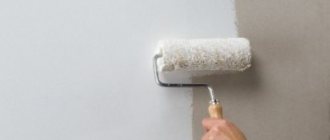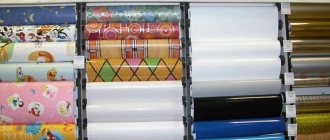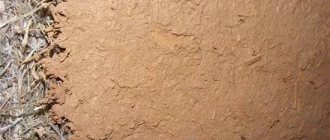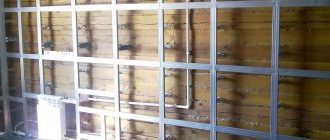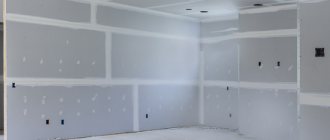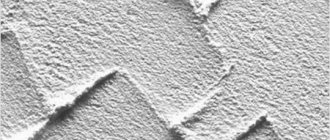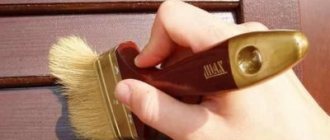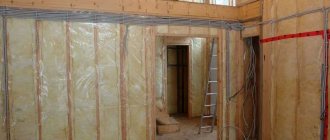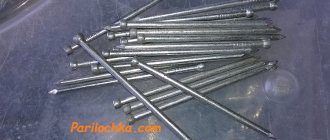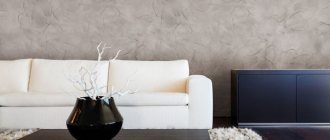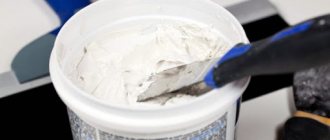19400 1 3
Andrey October 9, 2016Specialization: facade finishing, interior finishing, construction of dachas, garages. Experience of an amateur gardener and gardener. We also have experience in repairing cars and motorcycles. Hobbies: playing the guitar and many other things that I don’t have time for :)
Interior wall decoration is an operation that every home craftsman has to face in the process of performing home renovations. Currently, there are many finishing technologies and a wide selection of materials for these purposes, which often confuses people when choosing. To help you understand this issue, below I will try to tell you in detail about the most common modern materials and interior finishing technologies.
Wall decoration from the inside
First of all, I note that there are two types of interior decoration:
- roughing - ensures the preparation of walls for finishing. As a rule, preparation consists of leveling the surface and removing all kinds of defects;
- finishing – performs a decorative function.
Next, we will consider these types of interior decoration in detail.
Wallpaper
Wallpaper is the most common, commonly used way to decorate walls. For quite a long time, wallpaper in Europe was exclusively made of fabric or leather. Hence the name - they were not glued, but nailed.
Wallpaper today has a diverse range of products to suit all occasions and budgets. Here are paper and textile, vinyl and non-woven, acrylic and fiberglass, wood, cork, metal... Wallpaper in the form of huge photographs and paintings, as well as with 3D images. Moreover, each variety has its own undeniable advantages.
Paper wallpaper
Paper wallpapers are affordable and organic, and an impressive range of colors, textures and patterns opens the way for them to any room. In addition, anyone can handle gluing paper wallpaper, which allows you to save on repairs.
Paper covering is most suitable for the walls of the hallway, living room and bedroom. A variety is glued in the corridor, which, if necessary, can be painted, and the living room is decorated, as a rule, with multi-layered, embossed, primed types of wallpaper. Inexpensive, but “fun” paper wallpaper is also used in the nursery - if the artist in the child awakens, such a finish will be easy to quickly change.
The disadvantages of paper coatings include their fragility and fragility: only the best, multi-layer samples can last 5 years or more without visible loss of quality. And paper does not tolerate moisture well, is highly flammable and fades quite quickly.
Paper wallpaper in the interior, types and design examples
Top ↑
Photo wallpaper
Photo wallpapers became popular in the late 80s of the last century, and have not left homes to this day. This is because their range is truly limitless, the price is not exorbitant, and you can hang such wallpaper yourself. In addition, modern photo wallpapers are highly resistant to fading, repel dust, have an additional protective film and can be produced according to individual orders - for example, with portraits of household members. Actually, these are the advantages of paper photo wallpapers.
The disadvantages include the fact that such wallpaper requires absolutely flat surfaces and, like any paper, is not very durable. The average service life is 3-7 years.
Photo wallpaper in the interior, current options, photos
Top ↑
Fabric wallpaper
Textile wallpapers are linen, felt, silk, velor; on non-woven, paper or synthetic base.
The advantages of fabric upholstery are its naturalness, good thermal insulation, greater resistance to fading compared to paper wallpaper, decent appearance and richness of textures. And also a solid – on average 10 years – service life.
The most environmentally friendly option, paper-based linen upholstery, can be safely recommended for the nursery. Silk wallpaper, as if by magic, will transform an ordinary living room into a chic salon. And felt or velor wallpaper will make the bedroom warmer and more secluded. If more insulation is required, the walls are covered with textile wallpaper on a porous synthetic base: their thickness can reach 5 millimeters. This same variety is least susceptible to deformation. The maximum period of use of such coating is up to 10 years.
Negative qualities of fabric wallpaper: the need for regular cleaning, instability to mechanical stress, relatively high price. In addition, fabric wallpaper requires perfectly flat surfaces, as well as knowledge of the nuances of application to walls.
Textile wallpaper in the interior, advantages and disadvantages, photos
Top ↑
Jute wallpaper
Jute wallpaper belongs to a wide family of design materials with natural plant coverings. They are also called wallpaper mats. They can be based on either paper or non-woven fabric.
Jute wallpaper is valued for its 100% naturalness, breathability, resistance to ultraviolet radiation and mechanical stress. And the characteristic, knotty structure elevates these wallpapers from the category of ordinary coatings to the rank of stylish designer features. Most often, jute is used when they want to emphasize the minimalism, eco or ethnic character of the interior. This type of wallpaper is used primarily for living rooms and bedrooms; However, the safety and hypoallergenic nature of jute makes it a welcome “guest” in children’s rooms.
The disadvantages of jute coverings include their ability to absorb odors (which is why you rarely see jute in kitchens), the need for regular cleaning and a considerable price. The average service life is 10-15 years.
Top ↑
Vinyl wallpapers
Vinyl wallpaper is on the crest of popularity today. Of course, this type of finishing can imitate stone, wood, plaster or, say, suede. It should be noted that vinyl wallpapers are also divided into a considerable number of subtypes: structural, with relief and a layer of foamed vinyl, with hot stamping and silk-screen printing effect.
The strengths of this coating include a high degree of sound insulation, the ability to mask small irregularities and roughness on the walls, and resistance to fading and moisture. Due to the fact that vinyl wallpapers are not afraid of water and steam, they are relevant in kitchens and bathrooms.
But vinyl wallpaper also has its drawbacks: airtightness, difficulty in gluing it yourself, relatively high cost, and also a not very pleasant smell that cheap samples can emit. Service life is on average 20 years.
Top ↑
Non-woven wallpaper
Non-woven wallpaper can be used for paper, fabric or vinyl wallpapers. These are rolls of cellulose fibers bonded with polymers. Their advantages are environmental friendliness, breathability, a wide palette of patterns, and also the ability to repaint these wallpapers and use them to smooth out small bumps and blemishes on the walls. The service life of non-woven wallpaper is about 10 years.
And now about the shortcomings. Firstly, not everyone can afford high-quality non-woven wallpaper. Secondly, dust accumulates in the “folds” of their embossing. They are also quite easy to damage, for example, when rearranging furniture. Finally, the non-woven covering must be glued to exemplarily clean, plain walls. Otherwise, stains and stains may be visible.
Top ↑
Acrylic wallpaper
It is believed that this is an analogue of vinyl coatings, which are based on paper, and foamed vinyl replaces polymer coating. Advantages: hypoallergenic, durable, practical, moisture-resistant, which allows you to use wallpaper in the living room, kitchen, and even the bathroom. And also resistance to mechanical stress and ease of handling. It is not surprising that acrylic wallpaper is preferred by families with playful children or pets.
Disadvantages: such wallpapers are inferior to their vinyl “brothers” in thickness and, therefore, in durability. And their color range is not so diverse. Application period is 10-12 years.
Top ↑
Glass wallpaper
This still non-trivial type of finishing is gaining more and more points - thin, glass yarn rolled into rolls. It consists of dolomite, sand and similar additives, so naturalness and harmlessness are one of the “trump cards” of glass wallpaper.
There are other advantages: high strength, resistance to chemical and mechanical influences, fire and moisture, and the possibility of painting. Fiberglass fabric is so presentable that it often adorns the walls of posh bars and restaurants. Nothing prevents the use of glass wallpaper in any room, but they look especially impressive in classic as well as modern living rooms.
The disadvantages include the complexity of installation and, especially, dismantling, and the requirement for an absolutely flat wall surface. In addition, glass wallpaper, due to the complex production technology, is an expensive pleasure. But the service life of the glass coating is up to 30 years.
Top ↑
Cork wallpaper
The raw material for their production is Mediterranean oak bark with its unique resinous substances. The advantages of the material are obvious: environmental friendliness, bactericidal properties, creation of a special, healing microclimate. Cork also has enviable insulating properties. If someone in an apartment, for example, plays music, the neighbors are unlikely to hear, because the traffic jam will absorb the decibels. It is also important that, unlike wooden coverings, cork does not ignite and does not support combustion. After all, the velvety nature of cork bark is pleasant to the touch, which is why it is used in rooms for very young children.
Among the disadvantages of cork wallpaper, mention should be made of a relatively narrow range of colors. It cannot be said that their patterns are monotonous, but their natural color is in the range of natural wood - from light yellow to dark brown. And it is also worth considering that they will not be cheap, although the high cost in this case is compensated by a rather long service life. Service life – up to 30 years.
Top ↑
Linkrust
It may seem that we are talking about a new product, but this material was invented back in 1877. These are rolls that are formed from wood flour mixed with wax, rosin, and linseed oil. The surface of the linkcrust is embossed and patterned, which gives the finish an expensive, respectable look.
The best qualities of linkrust are environmental safety, commendable thermal stability, durability, resistance to deformation, a wide selection of colors and shades, the ability to paint, and ease of maintenance. The shelf life of linkrust wallpaper is practically unlimited, which can be confirmed by the perfectly preserved interiors of many ancient houses.
Linkrust looks great in a classic, Victorian setting. However, it is also characterized by certain defects - for example, instability at low temperatures, a complex installation process, and high cost.
Magnificent wallpaper: linkrust in the interior, photo
Top ↑
Metallized wallpaper
Metallic/metallic wallpaper can be embossed, blackened, etched, painted, patinated... Thanks to its decorative variety, this type of wall covering is a signature technique of many famous designers.
Wallpaper covered with a layer of foil, namely they are called metal, is resistant to moisture, wear, and has good thermal insulation. Well, if they are of the mirror type, then they also have the ability to visually “spread” the space.
Metallic wallpaper in a noble shade is adored by fans of expensive, pretentious styles such as Empire, Art Deco and Art Nouveau. Designers especially recommend this wallpaper for decorating halls, lobbies and halls.
The disadvantages of this coating are air tightness and low resistance to mechanical stress. Metallic wallpaper also requires perfectly smooth walls... and considerable investment. Their shelf life is on average 10 years.
Top ↑
Liquid wallpaper
Liquid wallpaper, also known as flock and silk plaster. Despite the natural base, after hardening on the walls, this coating bears little resemblance to wallpaper. The advantages of liquid wallpaper are practicality, damaged fragments are easy to restore, environmental friendliness, the ability to allow air to pass through, and sufficient strength.
The disadvantages are the relatively high cost, as well as not such a wide selection of patterns and colors as is the case with conventional paper ones.
Liquid wallpaper is suitable for the hallway, hall, nursery, bedroom and living room. Average service life is 6-8 years.
Liquid wallpaper in the interior, design options, photos and videos
Top ↑
Wall finishing materials
Until recently, walls in private houses were simply covered with plaster, which was painted with water-based paints or wallpaper was glued onto them. Even earlier, the walls were simply whitewashed with lime. Today, the variety of materials used for wall decoration is so huge that it becomes more and more difficult to choose every year. Therefore, most consumers seek advice from professional designers who have information about all finishing materials. They are like fish in water in this category of building materials.
So, let's figure out what finishing materials exist.
This material is still very popular today. Moreover, quite a wide variety of it has appeared on the market:
and others, others, others
.
The assortment is wide, the choice is huge both in color, texture and structure. Manufacturers even offer paintable wallpaper. They have an original white color that can be repainted up to 15 times, choosing any paint.
Variety of wallpapers for wall decoration Source vistcard.ru
In fact, wallpaper is still popular, and its demand is not decreasing. The reason is the incredibly huge number of species and subspecies. At the same time, the market offers wallpaper that imitates other building materials. For example, brick, stone, sand, leather, wood and so on. That is, you can create a unique interior in your home with little money, decorating it in any style.
The only requirement for the wallpapering process is that the wall is level. Therefore, wall surfaces are carefully plastered, puttied and sanded. If the house is wooden, then its walls are covered with plywood or plasterboard; today they have been replaced by OSB boards. It is the leveling of the wall surface that increases the cost of finishing materials. Wallpaper itself is an inexpensive material, of course, in comparison with other materials.
Regarding the choice of wallpaper, some criteria should be noted:
paper wallpaper is short-lived
, are afraid of moisture and temperature changes;
vinyl wallpaper is the thickest
, they easily cover minor wall defects and plane differences;
under non-woven fabrics
be sure to lay
leveling layer
, because this type of wallpaper is translucent and all dark spots can be seen through it;
if you choose the right wallpaper
, then they will fit perfectly into the room;
today you can use it, where the owner of the house chooses a drawing, pattern or photograph.
Photo wallpaper on the wall of the house Source plejadatapet.pl
Paints
Let's start with the fact that decorating walls in a private house with paints is at the peak of popularity. Their variety on the market is not as large as that of wallpaper, but they are represented by a good line. We must immediately make a reservation that before painting the walls must be leveled to the maximum. Craftsmen often apply several layers of finishing putty to achieve the perfect result.
Variety of paint and varnish products Source m.2gis.ru
What manufacturers of paint and varnish products offer:
Acrylic paints
. After drying, this material forms a durable film on the walls that can even be washed with water. The colors of acrylic paints are bright and saturated. But this material belongs to the category of “non-breathable”.
Silicone
. This is a breathable material that is applied to the surface of the walls in a fairly thick layer, so it covers minor defects and flaws well. Forms a durable film. Disadvantage: the price is high.
Silicate
. They are based on liquid glass, hence the excellent strength characteristics. But for the same reason, it is impossible to apply another material to a wall coated with silicate paint. If you need to carry out repairs, you will have to get rid of this paint coating. In this case, the paint itself applies only to mineral surfaces: plaster or putty. It is better not to use metal, polymers, wood under silicate paint - it will peel off.
Decorative plaster
This general term refers to a layer of construction and decorative mixture applied to the surface of the walls. It levels the walls, insulates them, insulates them, and is also, of course, one of the most ancient methods of beautifying a home inside and out.
Plaster mixtures can be divided according to two criteria - according to the composition of the mixture and according to artistic qualities.
Mineral plaster
Mineral plaster is the most economical type of plaster. This is due to the base of the mixture - cement, which is “seasoned” with chemical additives that provide increased moisture resistance. To this we can add environmental safety, vapor permeability, resistance to fungi and mold, temperature changes, as well as fire safety.
Among the disadvantages are the not very diverse color palette and the complexity of application. But the average period of operation of a mineral coating does not exceed 15 years.
In addition to mineral, there is also: silicate, based on liquid glass; silicone, which is based on silicone resins; polymer - with acrylic resin in the composition. Silicone and mineral plasters have the longest service life.
Top ↑
Textured plaster
[ads_block] Textured (structural) decorative plaster is a way of decorating walls that can be called an unfading classic. Due to the fact that the plaster mixture contains various additives (pebbles, fibers, marble chips or ground bricks), this finish can look like rock, valuable wood, cork bark, sand patterns, cracked clay, dug velvet.
Textured types of plaster include the famous “fur coat”, as well as bark beetle plaster, a method of finishing halls and hallways that has been popular for many decades.
Textured plaster is an excellent solution for those who want to get a unique interior. It will definitely provide picturesqueness and sophistication. And at the same time, strength, durability, and fire resistance. Plaster will help hide small defects on the walls, and its price is not bad at all. Textured plaster will not put to shame any of the palace, classical interior styles; it will be a good find for the hall, living room, and dining room.
Judging by the reviews, this design has one drawback - it is difficult to remove when the need for new repairs arises. The time during which textured plaster will not lose its attractiveness is 15-20 years.
Top ↑
Venetian plaster
It's hard to believe that this type of coating is over 500 years old. “Venetian” creates the impression of a noble stone - marble, granite, onyx, jasper, opal, malachite, amber. Such a sophisticated type of decoration literally asks for the walls of spacious living rooms, where there are fireplaces, hanging canvases in lush frames and the spirit of the Renaissance is in the air. Venetian plaster is unique: there are no two identical copies of it in the world! It is precisely this that can be seen inside the palaces of the Venetian doges and the villas of Italian aristocrats. “Venetian” is not only enchantingly beautiful, but also safe, moisture-resistant, durable and capable of pleasing the eye not for years, but for centuries! But the price also matches it.
Top ↑
Video description
From the video you can learn how to choose the right paint:
Water soluble
. This is a large group of paints for interior decoration of house walls. From the name it becomes clear that the composition is diluted with water, which evaporates after application to the wall. Masters believe that this is an ideal option for interior decoration of residential premises.
Latex
. It’s clear here – the base is latex. Such paints belong to the “washable” category. A powerful film that remains on the wall surface protects the painted surface from almost all types of loads. The best option for wet rooms. Experts recommend painting wallpaper with the latex variety.
Alkyd
. They contain linseed or soybean oil, organic and acidic substances. These are bright colors, quite durable and highly wear-resistant. Ideal for residential premises.
Painted walls of the room Source trendideas.net
Which paint should you prefer? Even a specialist cannot answer this question. Just take into account that it is better to use water-soluble ones in bedrooms, acrylic or latex in hallways. In wet rooms it is better to use alkyd, latex and acrylic.
Decorative plasters
Another popular category of materials for home interior decoration. These are plaster mortars, with the help of which they not only level the walls of a private house, but also form the decorative filling of rooms. What does the modern market offer today?
Textured plaster
This is a highly viscous and coarsely dispersed solution, the fillers of which are various types of fibers, stone chips, mica, pebbles, glass, etc. Can be applied to brick, concrete, wood and plastered walls.
Manufacturers offer a wide range of textured plasters that create different structures on the walls. The most popular: bark beetle, lamb, fur coat. Typically, such plasters are made based on cement. The peculiarity of this material is that the texture appears immediately after applying the plaster layer.
Textured plaster “Bark beetle” Source vseprobki.ru
Structural
This finishing material has a thin-layer structure, in which the base is acrylic or silicate, and the fillers are quartz or marble chips. Therefore, its appearance is a heterogeneous granular surface. Today, manufacturers offer a fine-grained structure that is very similar to even and smooth plaster.
The structural material is easy to lay even on plasterboard, chipboard, plywood and OSB. Not to mention the brick or concrete surface. It is not recommended to use this type of finish in damp rooms.
Structural plaster for interior work Source talkdevice.ru
Venetian plaster
Of all the plaster mixtures, this is the most expensive. The process of applying this type of plaster is also complicated. It is applied in several thin layers - up to 6 layers, each of which is well dried before applying the next one.
The end result is an imitation of marble or onyx. Today, manufacturers offer a variety with imitation of precious metals.
Venetian plaster on the wall inside the house Source vi.decorexpro.com
Specific types of plasters
We will not describe all the plaster mixtures present on the modern building materials market, we will simply list them:
What types of wall decoration are the most popular today, which are the most practical, and which are fashionable and spectacular? Let's try to answer these questions.
All wall finishing options, overview of materials, advantages and disadvantages.
Wallpaper is the most common, commonly used way to decorate walls. For quite a long time, wallpaper in Europe was exclusively made of fabric or leather. Hence the name - they were not glued, but nailed.
Dye
The market offers a truly huge number of all kinds of interior paints. Water-based ones are considered the safest and non-toxic, while organic-based ones, when dry, form a denser, shiny layer. You can choose moisture-resistant paint, which is suitable for the kitchen, and vapor-permeable paint, which would be appropriate, for example, in the hallway.
As for decorative properties, paints come in glossy, matte and even embossed. The former are suitable for perfectly smooth surfaces, while the embossed one can hide roughness and small errors on the walls.
- Water-based paints have the “softest” chemical composition. Their other advantages include an attractive price and a huge selection of colors and shades. Disadvantages include instability to abrasion and high humidity.
- Acrylic paints are more tolerant of fumes, but drops or streams can destroy them. The most durable among water-soluble paints are latex paints. They can even be washed, but they are not very tolerant of ultraviolet radiation, and they are more expensive. Walls coated with acrylic-based paint are not afraid of sunlight, are non-toxic and do not fade for 15-20 years. The disadvantage of such paints is their long drying time.
- Alkyd paints are inexpensive, easy to use, have a wide range of colors and dry within an hour after application. True, alkyd-based dyes are short-lived - a year later, the walls may become stained and lose their original brightness. They also do not like sunlight, and most importantly, they are quite toxic. In connection with the last point, these paints are not recommended for bedrooms and children's rooms.
- Silicate paints are created on the basis of liquid glass with the addition of pigments and fillers. Most often they are used on verandas, balconies, and basements - where resistance to moisture and temperature changes is required.
- Silicone paints are vapor-permeable, have dirt-repellent properties, are not afraid of water and create a fairly durable coating layer. It is not surprising that their service life is a quarter of a century. Silicone paints can be used to decorate bathroom walls, use them in the hallway, and in the kitchen. It should, however, be remembered that the bumps and depressions on walls covered with this relatively new type of paint and varnish products will become more noticeable.
- Oil paints with drying oil as a base are rarely used today for interior decoration. The reason is the harmful components that are used in their production. In addition, oil compositions take a long time to dry, do not allow surfaces to “breathe”, and can bubble and crack. The merits of oil paints include, perhaps, their affordability. Because of this, oil paints can be useful in utility rooms and utility rooms - they are used to paint pipes, window frames, and heating radiators.
- Enamel is often called upon to help when renovations are underway. Among the advantages of enamel dyes are a budget price, aesthetics (it forms a smooth, glossy film), and durability that exceeds the durability of oil and alkyd paints. Enamel is called a universal coating because it easily applies to any surface, be it brick, concrete or wood, and dries within 24 hours. Paint resists moisture well, which is why bathroom walls are sometimes covered with enamel. But we must not forget that enamels are fire hazardous, which is why they should not be used near a stove. The durability of enamel paint depends on the type and ranges from 10 to 15 years.
Top ↑
How to do wall cladding yourself
Step-by-step instructions for covering walls include:
- Cleaning the surface of all types of contaminants, degreasing it if necessary;
- leveling the surface, using primer, putty and other materials depending on the condition of the wall;
- and the cladding process itself, finishing materials are either attached to special adhesives or screwed with self-tapping screws. They erect frame structures to secure the products, and also use slats. Here everything also depends on the type of cladding chosen.
The cladding process depends on the type of cladding chosen.
There are many options for decorating walls, it’s not difficult to find one you like. When choosing, it is important to take into account the type of surface and the purpose of using the materials, because in addition to decorative functions, they can also have practical ones. You can install the products yourself without spending money on professional services.
Decorative rock
Decorative brick/stone. Today, few people will be surprised by this method of decorating living rooms and bedrooms, although recently brickwork was not allowed beyond the hallways. It's all about fashion. It turned out that brick as a method of decoration organically combines with many current styles - from classic and rustic to minimalism and loft.
Rigid tiles that imitate brick are based on gypsum, cement, clay and other compounds. So, white gypsum tiles are the most affordable. It is quite light in weight; for its laying you need to purchase special glue.
The main disadvantage of this material is its high moisture absorption - this should be taken into account when planning repairs and should not be used in rooms with high humidity. The average service life is at least 15 years.
In addition to brick, walls can be covered with decorative artificial stone, which imitates sandstone, shell rock, slate, tuff, basalt, etc. Despite the variety of textures, decorative stone is produced mainly from gypsum, sand, clay, cement and corresponding dyes.
The advantages of this finishing option are diversity, which allows the wildest design fantasies to run wild. Artificial stone is quite easy to install, it is hygienic, and lightweight, which can also be considered an advantage.
Decorative stone is most often used to highlight corners, openings, arches, frame a fireplace, in other words, to create stylish accents. Service life if treated with care is up to 30 years.
Decorative stone in the interior: design options, photos
Top ↑
Siding
Combined facade - siding and decorative stone.
Sidings are cladding of building walls that perform two functions: utilitarian (protecting buildings from external influences such as rain, wind, snow, sun), and aesthetic (decorating the facade of buildings).
of siding , and we will now briefly describe their properties:
8.1 Aluminum siding
– perfect for offices, residential premises in multi-storey buildings. Due to the softness of the panels, the use of this material allows you to update walls and ceilings in a short time without significant costs or complex repairs.
8.2 Wood siding or laminated lining
– contains wood fibers, compressed at high temperatures with a special resin. Externally, the texture imitates natural wood. This siding is very expensive and is flammable.
8.3 Steel siding
Finished with metal siding.
- industrial engineering. It has heavy material weight and is susceptible to corrosion.
8.4 Fiber cement siding
– fire-resistant material made of cement and cellulose fibers. Looks like wooden boards, thanks to the special texture of the application. It is used for finishing kindergartens, clinics, and educational institutions.
Pros:
- Will last a long time (at least 60 years)
- Has a presentable appearance
- Easy to install and handle, easy to clean and repaint
- Doesn't fade
- Flexible and lightweight
- Does not require special skills for dismantling
- Able to withstand temperature changes, etc.
Minuses:
- price due to novelty for the market
8.5 Ceramic siding
– it can perhaps be called the “golden mean” in terms of price criterion. Its composition is a mixture of clay and some natural materials.
Ceramic tile
This finishing material can be called eternal: trends change, but bathrooms and kitchens are still decorated with tiles. Ceramic tiles have earned trust due to such qualities as environmental safety, moisture resistance, hygiene and unpretentiousness in everyday life, immunity to fungi and bacteria, abrasion and fading. And the variety of formats, colors and textures, copying the appearance of noble stones, minerals, crocodile skin and much more, gives tiles a pass into any room. High-quality ceramic facing material can serve for 50 years or more. The only thing that is required is to restore the seams between the slabs.
Top ↑
Porcelain tiles
Porcelain tiles are characterized by strength, greater than that of tiles, environmental friendliness, low degree of water absorption, resistance to chipping, and resistance to low temperatures. The last point makes porcelain stoneware the leader in finishing when it comes to balconies, terraces, loggias and verandas.
As for the range of colors and textures of porcelain tiles, it will satisfy any tastes and whims. Porcelain tiles will last for more than one generation. The disadvantages of this coating include its impressive weight and relatively high cost.
Top ↑
PVC panels
Finishing with PVC panels will cost 30-40% less than with ceramic tiles. In addition to being cheap, PVC panels are practical, easy to use, and insensitive to temperature changes. Installation of the panels is also quite simple. Contrary to rumors, PVC does not emit toxic substances and is considered a safe finishing agent. You don’t have to worry about the appearance of the panels, and they come in different colors, for 8-10 years.
Among the disadvantages of PVC finishing are its lower strength compared to ceramics, toxicity when burning, and also, oddly enough, cheapness: for many this is an indicator of lack of prestige.
Top ↑
Stained glass ceiling decoration
Stained glass ceilings have a number of advantages over conventional materials:
- Beautiful and unusual appearance;
- Easy to install: installation of the structure is easy to do with your own hands - stained glass windows are installed using the assembly method.
- Practicality in operation: the ceiling is made up of separate parts that are easily replaced in case of damage; they are easy to wash and wipe off dust;
- Environmental safety: the stained glass window is made of metal and glass - no plastic!
The undeniable advantages of such a ceiling covering include resistance to moisture - because of this, its use in bathrooms is popular.
MDF panels
MDF panels are a modern modification of particle boards, known as chipboards. In the production of MDF, however, harmful phenol is not used, which makes this product environmentally friendly. The advantages of MDF include a wide range of products: manufacturers offer multi-colored, ornamented panels, smooth and with a relief surface. They are easy enough to mount on walls, they are durable, have a high thermal conductivity coefficient, are insensitive to fungus and mold, and since they are covered with a laminated film, they are also insensitive to moisture. The service life of MDF panels is 15 years.
Top ↑
3D panels
Most of these three-dimensional, relief products are made from gypsum, although they can be made from MDF, bamboo, reed, plastic, glass, aluminum... In stores they will also kindly show you acrylic 3D panels, leather, porcelain stoneware, samples with built-in LED- backlight. What do all these variations have in common? In general, 3D panels are hypoallergenic and non-toxic, they attach quickly, and have good insulating qualities.
3D wall panels in the interior: types, selection, photos
A serious bonus is the ability to manufacture custom panels. A wide selection of samples allows you to fit this finish into any style: bamboo 3D panels will suit simple, emphatically eco-friendly interiors, 3D panels with a metallic sheen and futuristic pattern will highlight high-tech and techno, plain 3D panels will add zest to a neoclassical setting, and panels with a patina effect will harmoniously complement art deco and modern.
Among the disadvantages of this coating, consumers cite the ability of the panels to accumulate dust on a textured surface. And psychologists add: an excessive number of convex patterns will not only overload the interior, but can provoke irritability and poor health. Based on this, it is better to use 3D panels in fragments - on one wall, for example.
Top ↑
Sheet materials
The sheet material used for interior wall decoration is lining, laminate and similar options. The lining can be made of natural wood, MDF or various types of plastic. It is laid on a prepared sheathing, which allows you to completely hide the imperfections of the wall in the form of unevenness and potholes. The block house is laid in a similar way. It is made from natural wood and is similar in appearance to a rounded log. This material is best suited for finishing country houses and steam rooms in private homes. Although laminate is a floor covering, it is also often used for wall decoration. If the surface of the walls is quite flat, then it is laid using the adhesive method; in all other situations, a wooden sheathing is also built under it.
Drywall
Drywall is a worthy alternative to plaster. It is used to create hanging, sub-ceiling systems, for decorating ventilation, pipes, utilities, as well as for covering walls.
Most often, plasterboard is used to decorate rooms with normal humidity - hallways, living rooms, bedrooms. But there is also a special, moisture-resistant drywall, the service life of which can last up to 10 years.
Drywall is a good sound insulator; it absorbs excess moisture and creates a perfectly flat surface. Installation of plasterboard products is not difficult, and they can be cut and used to create various shapes for decoration.
The disadvantage of drywall is that it “eats” the volume of the room, and after installation on the walls it requires puttying of the seams and finishing. It’s also depressing that hanging a TV or shelf on a wall covered with plasterboard is problematic.
Top ↑
Modern flooring
When choosing finishing materials for flooring, you should take into account the purpose of the rooms of the apartment or house. For example, wooden flooring looks especially authentic in the kitchen, but it requires special care there. It is also necessary to pay attention to the fact that some synthetic materials can cause allergies in people living in the house.
Significant indicators include the appearance of the material, its moisture resistance, as well as the base on which the material will be installed.
Unusual types of tiles
For a long time, tiles have been the leader among floor coverings for bathrooms and kitchens; however, this is a rather “conservative” material that is difficult to improve. Only relatively recently have such variations of the usual surfaces appeared, such as volumetric, liquid and pebble tiles.
The volumetric tile has bizarre shapes: it is concave on one edge and convex on the other. Such tiles look especially impressive on the wall, giving the room a stylish and status look. It should be noted that installation of the material is complicated and therefore an expensive service.
Liquid tiles allow you to create a unique room design: they change color and image under mechanical influences. Liquid tiles are laid mainly on the floor - there their properties can be fully revealed.
Pebble tiles are used to decorate bathroom walls. It consists of many stones glued to a tile base.
Floor array
High-quality flooring is made from solid wood. This material replaces parquet. Production is simplified by the fact that technological processes such as sanding and varnishing are carried out in the factory. The solid board is laid in the same way as parquet - by gluing it to the base.
Artistic parquet
Modern technologies have also affected the production of parquet. Thus, artistic parquet is an expensive floor covering made from various types of wood. To create a pattern, panel parquet is used or decorative elements are combined with strips of piece parquet.
Marmoleum
An innovative flooring material is improved linoleum. This is an environmentally friendly coating made from natural raw materials.
Marmoleum does not warp or fade, has good thermal insulation properties, is non-toxic, and can withstand heavy loads without loss of performance.
Due to its low cost, this material will soon be able to replace the usual laminate.
Innovative finishing materials that have emerged fit harmoniously into any interior. The advantages of such materials are obvious: safety for the health of those living in the house, environmental friendliness, high wear resistance, original appearance. Innovative materials are expensive, but these costs are worth it.
